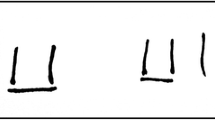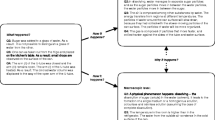Abstract
This study describes the types of explanations one student, Sharon, gives and prefers at different ages. Sharon is interviewed in the second grade regarding multiplication of one-digit numbers, in the fifth grade regarding even and odd numbers, and in the sixth grade regarding equivalent fractions. In the tenth grade, she revisits each of these concepts again. The study investigates the different forms Sharon’s explanations take at different ages as well as how she perceives the nature of mathematical explanations at different ages. Sharon’s explanations are also used to investigate her conceptualization of the number zero, a concept which runs across the curriculum at different ages. Finally, the study explores a method for investigating the long-term mathematical development of one student. Implications for future research are discussed.






Similar content being viewed by others
References
Achinstein, P. (1983). The nature of explanation. New York: Oxford University Press.
Anthony, G., & Walshaw, M. (2004). Zero: A “none” number? Teaching Children Mathematics, 11(1), 38–41.
Balacheff, N. (2010). Bridging knowing and proving in mathematics: A didactical perspective. In G. Hanna, H. N. Jahnke, & H. Pulte (Eds.), Explanation and proof in mathematics: Philosophical and educational perspectives (pp. 115–136). New York: Springer.
Ball, D. (1990). Prospective elementary and secondary teachers’ understanding of division. Journal for Research in Mathematics Education, 21(2), 132–144.
Ball, D., & Bass, H. (2000). Making believe: The collective construction of public mathematical knowledge in the elementary classroom. In D. Phillips (Ed.), Yearbook of the National Society for the Study of Education, constructivism in education (pp. 193–224). Chicago, IL: University of Chicago Press.
Board of Studies NSW (2006). Mathematics K-6 syllabus. Retrieved February 5, 2010 from http://k6.boardofstudies.nsw.edu.au/files/maths/k6_maths_syl.pdf
De Villiers, M. (1990). The role and function of proof in mathematics. Pythagoras, 24, 17–24.
Dreyfus, T. (1999). Why Johnny can’t prove. Educational Studies in Mathematics, 38(1–3), 85–109.
Eynde, P., De Corte, E., & Verschaffel, L. (2006). Epistemic dimensions of students’ mathematics-related belief system. International Journal of Educational Research, 45(1–2), 57–70.
Fischbein, E. (1987). Intuition in science and mathematics. Dordrecht, the Netherlands: Reidel.
Freudenthal, H. (1991). Revisiting mathematics education. Dordrecht, the Netherlands: Kluwer Academic.
Hanna, G. (1989). More than formal proof. For the Learning of Mathematics, 9(1), 20–25.
Hanna, G. (2000). Proof, explanation and exploration: An overview. Educational Studies in Mathematics, 44, 5–25.
Healy, L., & Hoyles, C. (2000). A study of proof conceptions in algebra. Journal for Research in Mathematics Education, 31(4), 396–428.
Israel National Mathematics Curriculum (2006). Retrieved December 10, 2009, from http://cms.education.gov.il
Krummheuer, G. (1995). The ethnography of argumentation. In P. Cobb & H. Bauersfeld (Eds.), The emergence of mathematical meaning: Interaction in classroom cultures (pp. 229–269). Hillsdale, NJ: Lawrence Erlbaum Associates.
Krummheuer, G. (2000). Mathematics learning in narrative classroom cultures: Studies of argumentation in primary mathematics education. For the Learning of Mathematics, 20(1), 22–32.
Lampert, M. (1990). When the problem is not the question and the solution is not the answer. American Educational Research Journal, 27(1), 29–63.
Levenson, E. (2010). Fifth grade students’ use and preferences for mathematically and practically based explanations. Educational Studies in Mathematics, 73(2), 121–142.
Levenson, E., Tirosh, D., & Tsamir, P. (2009). Students’ perceived sociomathematical norms: The missing paradigm. The Journal of Mathematical Behavior, 28, 83–95.
Levenson, E., Tsamir, P., & Tirosh, D. (2007). First and second graders’ use of mathematically-based and practically-based explanations for multiplication with zero. Focus on Learning Problems in Mathematics, 29(2), 21–40.
Linchevsky, L., & Williams, J. (1999). Using intuition from everyday life in ‘filling’ the gap in children’s extension of their number concept to include the negative numbers. Educational Studies in Mathematics, 39, 131–147.
Maher, C., & Martino, A. (1996). The development of the idea of mathematical proof: A 5-year case study. Journal for Research in Mathematics Education, 27(2), 194–214.
Mancosu, P. (2008). Explanation in mathematics. In E. Zalta (Ed.), The Stanford encyclopedia of philosophy. Retrieved July 2, 2010 from http://plato.stanford.edu/archives/fall2008/entries/mathematics-explanation/
Mueller, M. (2009). The co-construction of arguments by middle-school students. The Journal of Mathematical Behavior, 28, 138–149.
National Council of Teachers of Mathematics. (2000). Principles and standards for school mathematics. Reston, VA: NCTM.
Nunokawa, K. (2010). Proof, mathematical problem-solving, and explanation in mathematics teaching. In G. Hanna, H. N. Jahnke, & H. Pulte (Eds.), Explanation and proof in mathematics: Philosophical and educational perspectives (pp. 223–236). New York: Springer.
Pogliani, L., Randic, M., & Trinajstic, N. (1998). Much ado about nothing—an introductive inquiry about zero. International Journal of Mathematics Education in Science and Technology, 29(5), 729–744.
Seife, C. (2000). Zero: The biography of a dangerous idea. New York: Viking Penguin.
Tall, D. (2004). Thinking through three worlds of mathematics. In M. Hoines & A. Fuglestad (Eds.), Proceedings of the 28th conference of the International Group for the Psychology of Mathematics Education (Vol. 4, pp. 281–288). Bergen, Norway: PME.
Tsamir, P., Sheffer, R., & Tirosh, D. (2000). Intuitions and undefined operations: The case of division by zero. Focus on Learning Problems in Mathematics, 22(1), 1–16.
Van Fraassen, B. (1980). The scientific image. Oxford: Clarendon.
Vinner, S. (1991). The role of definitions in the teaching and learning of mathematics. In D. Tall (Ed.), Advanced mathematical thinking. Dordrecht, the Netherlands: Kluwer.
Watson, A., & Mason, J. (2005). Mathematics as a constructive activity: Learners generating examples. Mahwah, NJ: Lawrence Erlbaum Associates.
Wilson, P. (2001). Zero: A special case. Mathematics Teaching in the Middle School, 6(5), 300–303, 308–309.
Yackel, E. (2001). Explanation, justification and argumentation in mathematics classrooms. In M. Van den Heuvel-Panhuizen (Ed.), Proceedings of the 25th conference of the International Group for the Psychology of Mathematics Education PME-25, (Vol. 1, pp. 1–9). Utrecht, the Netherlands: PME.
Yackel, E., & Cobb, P. (1996). Sociomathematical norms, argumentation, and autonomy in mathematics. Journal for Research in Mathematics Education, 22, 390–408.
Yackel, E., Cobb, P., & Wood, T. (1998). The interactive constitution of mathematical meaning in one second grade classroom: An illustrative example. The Journal of Mathematical Behavior, 17, 469–488.
Zazkis, R., & Chernoff, E. J. (2008). What makes a counterexample exemplary? Educational Studies in Mathematics, 68(3), 195–208.
Author information
Authors and Affiliations
Corresponding author
Rights and permissions
About this article
Cite this article
Levenson, E. Exploring one student’s explanations at different ages: the case of Sharon. Educ Stud Math 83, 181–203 (2013). https://doi.org/10.1007/s10649-012-9447-1
Published:
Issue Date:
DOI: https://doi.org/10.1007/s10649-012-9447-1




